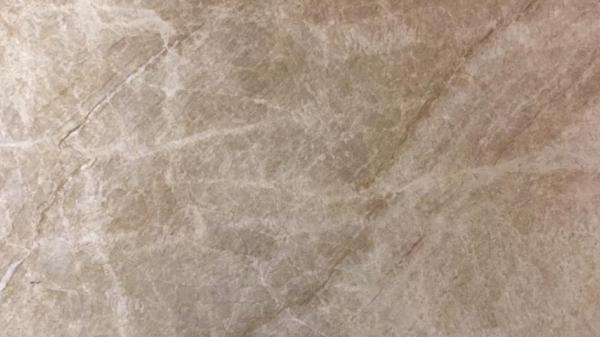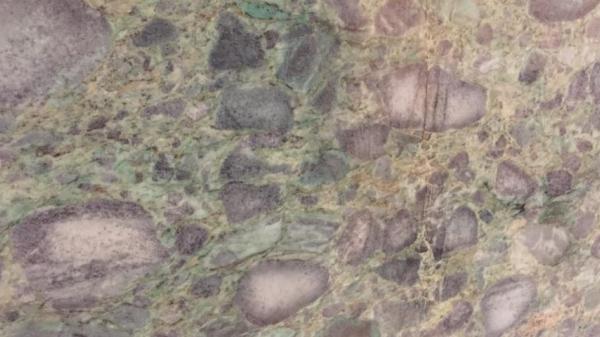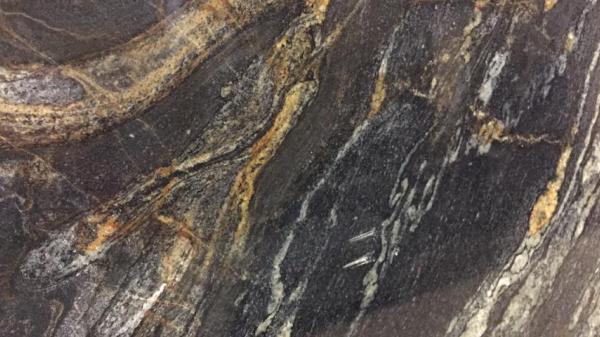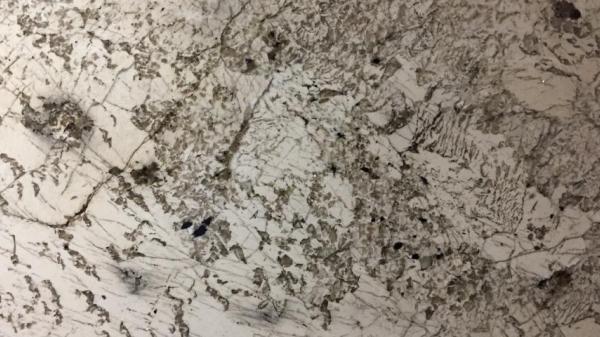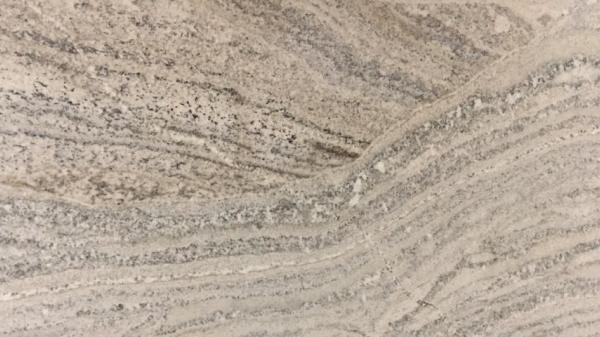The rock slabs on display in the lobby of Physical Sciences Building F-Wing on the Tempe campus are examples of the following rock types. They are shown here in the same east-to-west order as in the display.
Quartzite
Light-tan to cream-colored quartzite with a metamorphic foliation parallel to layering interpreted to represent original sedimentary layers. The slab is mostly composed of quartz crystals that originated as sand grains and then recrystallized and grew during metamorphism. The layers are highly deformed based on subtle folds within the layers. Parallel to the layers are lenses and veins of quartz, interpreted to have been precipitated from hot water that circulated in the rocks during metamorphism. Small folds locally bend the layers and veins. The youngest features in the slab are cross-cutting fractures, most of which are simple joints, but some are faults.
Metamorphosed Conglomerate
Metamorphosed, poorly sorted conglomerate composed of variably rounded clasts (cobbles and pebbles) in a finer grained matrix. Many of the cobbles are interpreted to be felsic volcanic rocks, such as rhyolite, but others are interpreted to be quartz-bearing sedimentary rocks. Some clasts exhibit layering that predated their incorporation into the conglomerate. Some cobbles and pebbles were stronger than the matrix and resisted deformation, largely retaining their original rounded shapes. Others were not as strong and were deformed into lenses. The greenish color of the matrix and some clasts is due to greenish metamorphic minerals, including chlorite and epidote. The rock is cut by some fractures that occurred after metamorphism.
Metamorphic Rocks and Tan Igneous Rock
Banded gneiss and migmatite, consisting of light- to dark-gray compositional layers and foliation, with local tan, irregular masses of pegmatite. The layers exhibit tight folds formed by extreme shortening of the rock perpendicular to the folds. Larger folds contain smaller folds that formed on their flanks during the folding process. The tan units are granite, which varies in grain size from medium-grained granite to coarse pegmatite composed of cream-colored potassium feldspar, gray translucent quartz, and black tourmaline. Some of the granite masses are folded, which indicates they were already present at the time of the main deformation. The feldspar-rich pegmatite was stronger than the rock around it, deforming into irregular clumps that locally lack foliation.
Igneous Rock - Pegmatite
Pegmatite containing coarse crystals of potassium feldspar, one nearly a meter in diameter. The slab also contains light-gray to medium-gray, translucent quartz, which occurs as crystals dispersed throughout the slab and as longer crystals intergrown with the feldspars, forming graphic granite. Other minerals include black tourmaline and minor amounts of muscovite. The rock has no structural fabric except for a few fractures, some of which are stained brownish-red by iron-oxide minerals.
Igneous Rock - Granite
A layered aplite-pegmatite complex of granitic composition. The aplite is pinkish cream and displays a fine-grained, sugary texture. The pegmatite is light gray and contains coarser crystals of feldspar and quartz. Some layers contain abundant red garnet. Aplite-pegmatite complexes are interpreted to represent crystallization from a water-rich magma. The water allows large crystals to grow in the pegmatite, whereas the fine-grained aplite crystallized in zones that lost this water. There are several generations of aplite-pegmatite bands cutting across and truncating older bands. The older bands are less aplitic and contain a higher percentage of dark minerals. Cross cutting all older rocks are light-colored pegmatite dikes containing potassium feldspar, quartz, and black tourmaline.
The School of Earth and Space Exploration is grateful for a gift from Alice and Peter Buseck making the display possible, and gives thanks also to Arizona Tile for donating the materials for the exhibit.
